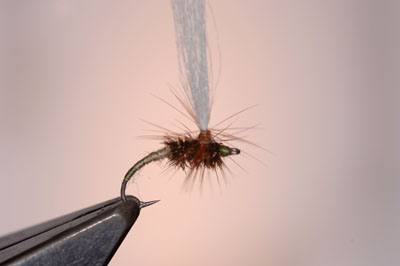
Klinkhamer Special
This is one of those patterns that in my opinion changed the way we think about trout and grayling fishing and gave us the ability to present an emerging fly in such a way that it is presented in the most natural manner similar of any aquatic insect that the fish are likely to see in order to feed every day of its life.
Do not just think that this is just a river pattern. It isn’t. It will catch fish anywhere. All you have to do is adapt it to the environment and conditions that you are fishing.
The dressing is as follows:
- Hook: Partridge Klinkhammer code GRS15ST. These have been developed since the original fly was tied and are bigger in size than you think. Size 18 is similar to size 14. You may also use Tiemco TMC 200R’s but if you do bend it with flat-nosed pliers about 3mm from the eye.
- Thread: For the body use tan 8/0 or colour to suit pattern. For the hackle use Danvilles Spider Web.
- Body: Flyrite dubbing No 22 Cahill light Tan
- Thorax: 2 peacock herls
- Wing Post: Siliconised Polypropylene yarn
- Hackle: Red Game or to suit pattern
Fix the hook into the vice as shown and attach the thread with a jam knot as shown.
Take a length of the yarn of 2″ and attach it to the top of the hook shank. Leave a short waste end on the bend side of the yarn and remove this with a diagonal cut down towards the bend of the hook.
Secure the waste down with turns of thread. then make touching turns back towards the eye and make several wraps of thread in front of the post to hold it upright.
Now make several turns around the base of the post.
Now take the silk down the hook shank in touching turns to the bend of the hook.
Dub the thread with the body material. The shape of the body is important in that you want it to be slim and then gradually thicker at the thorax. The slim body will be better able to penetrate the surface film on the water. Remember the idea is for the body to be under the water and the hackle above it.
Wind on the body. Remember to keep it slim.
In the picture above I have stopped a little too short of the wing post with the body dubbing. This will exaggerate the size of the thorax.
The fish won’t care I am sure.
Now select a good quality cock hackle and tie it in at the base of the post with the good side uppermost. To make sure that when I wind it around the post later it doesn’t come out I tie the stem down and fold it back towards the post and tie that down also. I then remove the waste.
You do not have to do this but I am sure that the dog or the cat or even both will appreciate it as when it does slip out they always seem to be in boot range.
Take the silk back to the end of the dubbing body and tie in two peacock herls.
These are the wonderful iridescent long fibres located on the stem of a peacock tail feather below the eye.
Before you tie them in the secret is to match the ends and remove the top 3″ as this is the weakest area of this feather.
You have a choice now in that you can wind the herls through forming the thorax and then over wind with the silk. (I think this is a little untidy)
Or as I have done is to take a pair of hackle pliers and connect the two herls together with the thread and wind them together to form a herl rope and wind this through. The choice is yours it’s your fly.
Form the head of the fly and whip finish.
Now comes the fun bit!
Change the position of the hook so that the head hangs down.
Attach the spider web thread at the base of the post with a jam knot.
Wind the hackle around the post making sure that each turn goes under the last.
It may help to pull the post tight to help you do this.
Wind the spider thread through the hackle twice and finish below the last turn of hackle securing it soundly.
Remove the waste hackle and whip finish.
In order to do this whip finish with a tool, you will need an extended whip finishing tool. if you do not have one revert to a hand whip finish.
Cut the post to size. The one here is a little short.
Secure with the tiniest dab of head cement at the post base.
The view from above
And more important the view from below.
A great fly. Have some fun with it.
It has been described as the best grayling catcher of all time.
If you have any questions then go to the forum.
Good tying.



















